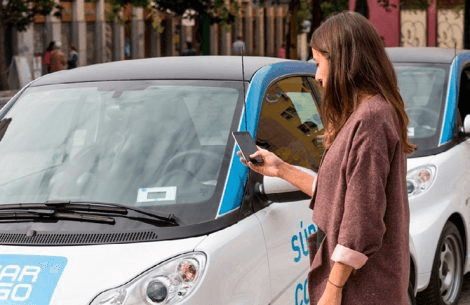In today’s rapidly accelerating world, innovation has never been more important. And that’s why successful businesses, ranging from long-established multinationals to startups, bet on change and adapting to the future. This report explores why transformative ideas have become so critical and how entrepreneurially minded people can drive change, whether they happen to be entrepreneurs or not.
To stay afloat, businesses need the best ideas
In today’s business world, there is no such thing as smooth sailing. The waves of rapid technological and societal change, disruption and the constant need for growth leave no room for companies to sit idly by or cruise along based on past momentum.
“Today you’re seeing traditional entry barriers into the market fading away, and the companies that succeed have a pipeline of new competitive advantages that drive growth, even as existing competitive advantages fade away,” says Rita McGrath, an author and one of the world’s foremost experts in strategic innovation.
Just like startups, successful companies need to think like an entrepreneur, getting into the right mindset and ready to jump upon good opportunities, with one eye on the present and another on the future, anticipating storms before they happen — or perhaps even figuring out a way to cause them. And if businesses are only as good as the talent they have, this also makes the entrepreneurial mindset a key trait to possess as a successful employee. Although entrepreneurs such as Elon Musk may make more headlines, intrapreneurs, working within companies, also have the ability to revolutionize industries, society and the environment.
“The entrepreneurial mindset helps old companies to remain young, alive, fresh, agile and alert even in a mature market,” says Peter Bryant, professor of entrepreneurship at IE Business School.
Many have learned this lesson the hard way. The lifespan of top companies has never been shorter. In 1958 the average time spent in an index of top companies was 61 years — today that has been reduced to 18 years. A study of the S&P 500 index even predicts that at the current rate of change, 75% of today’s top 500 US companies will be replaced by 2027.
“The entrepreneurial mindset helps old companies to remain young, alive, fresh, agile and alert even in a mature market”
Peter Bryant, Professor of Entrepreneurship at IE Business School
Besides that, the companies that have remained strong for decades generally have little to do with what they once were. “If you could take a snapshot of the values and processes of most companies 50 years ago — and did the same with a surviving company in 2014 — you would say it’s a different company other than, perhaps, its name and maybe its purpose and maybe its industry,” Lou Gerstner, former CEO of IBM, said in a 2014 interview. After graduation, most students end up working with an established firm. Even those who found startups often end up moving on to another company, says Concepción Galdón, IE University’s Social Innovation Director. But entering into a big company does not mean it’s time to set one’s entrepreneurial mindset or personal values aside.
“The leadership that really counts is the leadership that keeps a company changing in an incremental, continuous fashion,” according to Gerstner.—
DISCOVERY DRIVEN GROWTH BY RITA MCGRATH
THE ENTREPRENEURIAL MINDSET BY RITA MCGRATH

AMAZON
When Jeff Bezos envisioned Amazon in 1995, he dreamt of it becoming the world’s biggest bookstore. Yet, by the year 2000, Amazon was so much more as it branched off into becoming an online marketplace, selling nearly anything. Backed by incredibly efficient logistics, the company continued to grow and revolutionize the shopping, shipping, reading and entertainment sectors. In 2017, Amazon was voted by Fast Company to be the world’s most innovative company, as it worked on its cashier-free grocery stores and drone delivery services.
The first cashier-free Amazon Go store in Seattle. Photo: Amazon
Daring to share: Daimler’s Car2Go
Many car companies might be horrified by the idea of car sharing. Logic could suggest that if people started to share cars, it would reduce the need to buy private vehicles and, ergo, it could damage their business.

Employees in Daimler’s Business Innovation Division came up with the idea for Car2Go in 2007. Their dream was to create the first car-sharing system in the world without fixed rental locations.
Now, the program works through an app where customers can find a nearby car and rent it on-demand. Later, they can drop it off at their destination, from where another driver will pick it up.
It is affordable and many of the vehicles are electric and small, making it easy to park in congested urban areas, besides being an environmentally responsible option. The idea was identified as being complementary to the company’s core business, as it also drew on its fleet of smart cars. The company began testing in October 2008 in Ulm, Germany and since then it has expanded worldwide. By April 2017, the company had expanded to eight countries, 26 cities and has 2.3 million members.
“We want to beat the competition — on a permanent basis”
Dieter Zetsche, CEO of Daimler AG
But despite the success, Car2Go is not ready to stop changing. Daimler is continuing to invest in research and development, looking at autonomous driving. Now successfully poised in an innovative industry, the next step may be that customers won’t even have to drive themselves. And the lessons of Car2Go have also seeped into other Daimler businesses.
“At Mercedes-Benz we see the four key pillars for future mobility as connectivity, autonomous driving, car sharing, and electrification,” said Dieter Zetsche, CEO of Daimler AG and Head of Mercedes-Benz Cars in January 2017.—

NOKIA
Nokia began in 1865 as a pulp and paper mill. Thanks to its position on the Nokianvirta river and early success, it ventured into electricity generation three decades later. Later, Nokia merged with two other companies working with rubber and communications. In 1982, the company launched one of the world’s first mobile phones (around 10 kg). After reducing the size, Nokia decided to drop everything and focus on cell phones and network infrastructure. And over the 90s and early 2000s, it shot up to the top of the mobile phone market.
Left: One of Nokia’s much-loved cell phones. Right: Nokia when it was a pulp mill in the 19th century. Photos: Nokia
How to create change from within
While the need for innovation within companies is evident, how to go about doing it is not as straightforward. A study by McKinsey suggests that while 84% of global executives believe innovation is extremely important, only 6% are satisfied with innovation performance.
“In a world that’s changing really quickly, the only strategy that is guaranteed to fail is not taking risks”
Mark Zuckerberg
So, how do you get into the entrepreneurial mindset? And if you’re an employee with innovative ideas, what is the best way to bring them to fruition?
“Sometimes my students ask, ‘how are you going to teach me entrepreneurship?’ I tend to say, ‘I’m not going to teach you it in the standard way, but I’m going to create opportunities for you to learn through experience’,” says IE Business School’s Bryant. He explains that creating a safe but challenging place, in which to learn through experience and experiments, is extremely helpful in cultivating this sought-after perspective.
Once fostered, the entrepreneurial mindset requires coming up with or spotting great ideas that can be turned into opportunities. According to Nathan Marston, Chief Digital Officer for the McKinsey consulting firm, there are three areas of innovation within a company that can transform businesses.
First, there are product or service innovations — shiny, new products or services that address the needs of the clients. Secondly, there are process innovations, which change the company’s ability to deliver its product or service at a radically lower cost, or provide a better experience. Finally, there is a business model revolution. Why is a business model important? because it changes the company’s source of income or value chain in general and helps your business stay competitive.
GOOGLE
With the intention of finding the best ideas, Google practices the 20% time policy in which it allows employees to spend up to a fifth of their time working on projects they think would most help the company. Some of the results of this policy include Google News, Gmail and AdSense. Photo: Google
FACEBOOK
Every few months, Facebook engineers unleash their talents in “hackathons” or marathon coding sessions. It gives employees a chance to make a huge impact in a short time. The ideas for Facebook’s like button, chat feature and the timeline were all conceived at the all-night sessions. Being open to its employees’ ideas, Facebook has evolved from a basic platform to see friends into a global media company. Photo: Facebook
WATCH: THE ART OF INNOVATION TED TALK BY GUY KAWASAKI, MARKETING EXPERT AND VENTURE CAPITALIST

NESTLÉ
Nestlé founded Nescafé in 1938 as a way to deal with a surplus of Brazilian coffee. The company’s first major innovation came with the invention of instant coffee. But even with that, Nestlé wasn’t quite finished turning the coffee world on its head. In 1976, Eric Favre, a Swiss engineer and Nestlé employee came up with the idea for the Nespresso system. It was initially introduced to the Swiss market with disappointing results. However, using Nestlé’s resources to fight for the promising idea, it eventually revolutionized the market. Innovation, what else?
Nestlé Nespresso brewing system. Photo: Nespresso
Change the company, change the world
Just because you’ve taken a job with a big company doesn’t mean you have to give up the vision to make the world a better place. On the contrary, in the corporate world, there are businesses that are creating value for society and can make an excellent place for a rewarding career based on positive social change.
“You don’t have to be either a do-gooder or a sellout; you can create rewarding careers for yourself by being really good at your day job, but also creating value for not only your company, but the society,” says Christopher White, an author and leader of the Center for Positive Organizations.
“You can create rewarding careers for yourself by being really good at your day job, but also creating value for not only your company, but the society”
Christopher White, Author and leader of the Center for Positive Organizations
Galdón agrees, pointing out that contributing ideas that create positive change often results in a win-win-win situation. Not only can corporations have a huge impact on society, but socially positive ideas can also drive positive change in a business and improve the company’s standing with employees and customers. Those creative individuals with the ideas usually resonate a lot with top management, while the best ideas are those that match with the philosophy, values, strengths and identity of the companies concerned, Galdón adds.
“Social intrapreneurship is absolutely critical for the world. Organizations cannot behave the same way as they did in the past. People increasingly want to work for and buy from firms who form a specific identity and are responsible, and social intrapreneurship is an opportunity for organizations to evolve into the type of business that is going to be successful in the future,” Galdón concludes.—
What to ask yourself before presenting an innovative idea?
Expert Christopher White lays out the four questions that social intrapreneurs should consider to increase the chances that their good idea will get accepted.
WHEN?
Is it the right time to push ahead? Sometimes having the right idea on the wrong day means your idea flops, and vice versa. Think about budget cycles, strategic changes and leadership changes that should inform the way you pitch.
WHY?
Or, in other words, how do you frame the case for change? Match the way you frame it to the company’s culture and values.
WHO?
Who do you need to get on board? Which high level supporters and the influence system around them do you need? Also, think of who will resist the idea, who has something to lose, and how to incorporate that impact into your pitch.
HOW?
How do you present your innovation as something that fits within the ways of operating? And how can you use the resources and skills of your company to best support your initiative?

NINTENDO
Nintendo began in 1889 making handmade Japanese playing cards. But in the 60s it began to set its sights beyond the card business. Between 1963 and 1968 Nintendo set up a “love hotel” chain, a taxi company, an instant noodle business and more. But it was in the broader toy and game industry where the company continued to prosper and by the 70s it launched the world’s first home video game console. More than 125 years later and Nintendo is still a market leader in the game industry.
Left: Handmade Japanese playing cards made by Nintendo. Right: The Nintendo Switch console. Photo: Nintendo
BUSINESS ADMINISTRATION TAKEAWAYS
ESTABLISHED COMPANIES NEED INNOVATIVE AND ENTREPRENEURIAL IDEAS NOW MORE THAN EVER
INTRAPRENEURS HAVE A SUPPORTIVE AREA WHERE THEY CAN CARRY OUT THEIR IDEAS, AT RELATIVELY LOW PERSONAL RISK BUT WITH THE POTENTIAL FOR HUGE IMPACT
THE ENTREPRENEURIAL MINDSET MEANS ALWAYS LOOKING TOWARDS THE FUTURE AND CAN BE LEARNED
SINCE BUSINESSES HAVE SUCH A LARGE IMPACT ON SOCIETY, THEY CAN BE AN EXCELLENT STARTING PLACE FROM WHICH TO CREATE POSITIVE CHANGE
Further reading
- The Innovator’s Dilemma: When New Technologies Cause Great Firms to Fail by Clayton M. Christensen
- Crossing the Chasm: Marketing and Selling Disruptive Products to Mainstream Customers by Geoffrey A. Moore
- Originals: How Non-Conformists Move the World by Adam Grant
- Creative Intelligence: Harnessing the Power to Connect, Create and Inspire by Bruce Nussbaum
- Running Lean: Iterate from Plan A to a Plan that Works by Ash Maurya
This material has been prepared for general informational purposes only. Some information has been compiled by third party sources that we consider to be reliable. However, we do not guarantee and are not responsible for the accuracy of such. The views of third parties set out in this publication are not necessarily the views of IE University and they should be seen in the context of the time they were made.










